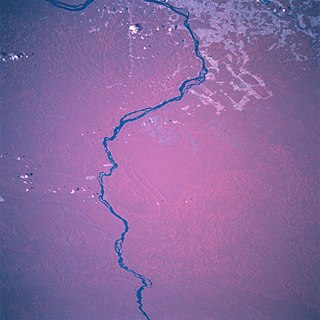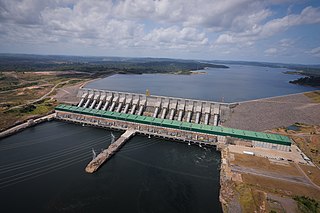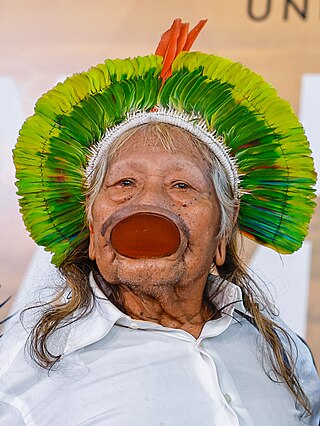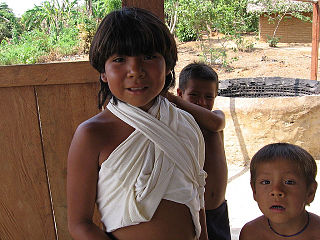Related Research Articles

The Xingu River is a 1,640 km (1,020 mi) river in north Brazil. It is a southeast tributary of the Amazon River and one of the largest clearwater rivers in the Amazon basin, accounting for about 5% of its water.

Indigenous peoples in Brazil or Native Brazilians are the peoples who lived in Brazil before European contact around 1500 and their descendants. Indigenous peoples once comprised an estimated 2,000 district tribes and nations inhabiting what is now Brazil. The 2010 Brazil census recorded 305 ethnic groups of Indigenous people who spoke 274 Indigenous languages; however, almost 77% speak Portuguese.

Francisco Alves Mendes Filho, better known as Chico Mendes, was a Brazilian rubber tapper, trade union leader, and environmentalist. He fought to preserve the Amazon rainforest, and advocated for the human rights of Brazilian peasants and Indigenous people. He was assassinated by a rancher on 22 December 1988. The Chico Mendes Institute for Biodiversity Conservation, a body under the jurisdiction of the Brazilian Ministry of the Environment, is named in his honor.

The Tapajós is a river in Brazil. It runs through the Amazon Rainforest and is a major tributary of the Amazon River. When combined with the Juruena River, the Tapajós is approximately 2,080 km (1,290 mi) long. It is one of the largest clearwater rivers, accounting for about 6% of the water in the Amazon basin.

Altamira is one of one hundred and forty-four municipalities in the state of Pará, in northern Brazil. It has an area of 159,533.73 square kilometres or 61,596.32 square miles, making it the largest municipality by area both in Pará state and Brazil, and until 2009 it was the world's largest municipal subdivision. It occupies 12.8% of the state's territory, 1.8% of Brazil's territory and 0.8% of South America. It also covers a more extensive area than 104 countries, and is comparable to the US states of Missouri and Florida.

The Kayapo people are an indigenous people in Brazil, living over a vast area across the states of Pará and Mato Grosso, south of the Amazon River and along the Xingu River and its tributaries. This location has given rise to the tribe's nickname of "the Xingu". They are one of the various subgroups of the great Mebêngôkre nation. The name Kayapo is used by neighboring groups rather than referring by the Kayapo to themselves; they refer to outsiders as Poanjos.

The Xingu are an indigenous people of Brazil living near the Xingu River. They are the Aweti, Kalapalo, Kamaiurá, Kayapó, Kuikuro, Matipu, Mehinako, Nahukuá, Suyá, Trumai, Wauja and the Yawalapiti peoples. They have many cultural similarities despite their different ethnicity and language groups. Xingu people represent fifteen tribes and all four of Brazil's indigenous language groups, but they share similar belief systems, rituals and ceremonies.
The Panará are an Indigenous people of Mato Grosso in the Brazilian Amazon. They farm and are hunter-gatherers.

The Rainforest Foundation Fund is a charitable foundation founded in 1987 and dedicated to drawing attention to rainforests and defending the rights of indigenous peoples living there.
The Xingu Indigenous Park is an indigenous territory of Brazil, first created in 1961 as a national park in the state of Mato Grosso, Brazil. Its official purposes are to protect the environment and the several nations of Xingu Indigenous peoples in the area.

The Belo Monte Dam is a hydroelectric dam complex on the northern part of the Xingu River in the state of Pará, Brazil. After its completion, with the installation of its 18th turbine, in November 2019, the installed capacity of the dam complex is 11,233 megawatts (MW), which makes it the second largest hydroelectric dam complex in Brazil and the fifth largest in the world by installed capacity, behind the Three Gorges Dam, Baihetan Dam and the Xiluodu Dam in China and the Brazilian-Paraguayan Itaipu Dam. Considering the oscillations of river flow, guaranteed minimum capacity generation from the Belo Monte Dam would measure 4,571 MW, 39% of its maximum capacity.
Darrell Addison Posey was an American anthropologist and biologist who vitalized the study of traditional knowledge of indigenous and folk populations in Brazil and other countries. He called his approach ethnobiology and combined research with respect for other cultures, especially indigenous intellectual property rights.

Amazon Watch is a nonprofit organization founded in 1996, and based in Oakland, California, it works to protect the rainforest and advance the rights of Indigenous peoples in the Amazon Basin. It partners with indigenous and environmental organizations in Ecuador, Peru, Colombia and Brazil in campaigns for human rights, corporate accountability and the preservation of the Amazon's ecological systems.

Rainforest Foundation US is a non-profit NGO working in Central and South America. It is one of the first international organizations to support the indigenous peoples of the world's rainforests in their efforts to protect their environment and fulfill their rights to land, life and livelihood.

Raoni Metuktire, also known as Chief Raoni or Ropni, is an Indigenous Brazilian leader and environmentalist. He is a chief of the Kayapo people, a Brazilian Indigenous group from the plain lands of the Mato Grosso and Pará in Brazil, south of the Amazon River and along Xingu River and its tributaries. He is internationally famous as a living symbol of the fight for the preservation of the Amazon rainforest and indigenous culture.

The Araweté are an indigenous people of Brazil. They are swidden horticulturalists native to the state of Pará.
Paulinho Paiakan was a leader of the Kayapo people, an indigenous tribe of Brazil. He led the Kayapo in their protests against the destruction of the Amazon rainforest.

Antônia Melo da Silva is a Brazilian human rights activist and environmentalist. In 2017, she received the Alexander Soros Foundation Award for Environmental and Human Rights Activism for leading campaigns against the construction of the Belo Monte Dam and other environmentally harmful projects in the Amazon rainforest.
The Kayapo: Out of the Forest is a 1989 color documentary film and the second of two films, the first being the 1987 film The Kayapo. Both films were directed by Michael Beckham with assistance by Terry Turner, a consulting anthropologist.

Tuíre Kayapó, also called Tuíra, was a Brazilian indigenous rights activist, environmentalist, and a chief of the Kayapó people. She was active in the movement against the Belo Monte Dam project on the Xingu River in the 1980s and constitutional amendment PEC 215 in the 2010s.
References
- ↑ "Indigenous Gathering in Altamira, Brazil in Defense of the Xingu River". Cultural Survival. 12 August 2010. Retrieved 28 February 2011.
- 1 2 3 4 Turner, Terence (1993). The Role of Indigenous Peoples in the Environmental Crisis: The Example of the Kayapo of the Brazilian Amazon. Johns Hopkins University Press. pp. 526–545.